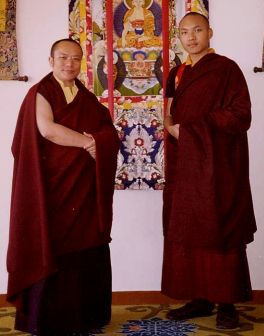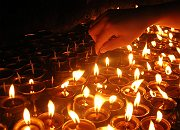His Holiness the Gyalwa Karmapa and His Eminence Tai Situ Rinpoche

The Root Lama - rTsa-ba'i-bla-ma
There are different types of Root Lamas a practitioner of Tibetan Buddhism can have, but I will only discuss the two most important ones here. They are the rTsa-ba'i-bla-ma and the bLa-ma'i-brgyüd-pa, translated as "Root Lama" and "Master of the Succession," respectively. Guru is the Sanskrit honorific term for "master," so it is often used when referring to one's Root Lama.
The head of a particular school of Tibetan Buddhism is the bLa-ma'i-brgyüd-pa who can be traced back many centuries, in a continuous succession of transmissions. brGyüd means "to transmit, conduct, stream through, continue, pass on." It also means "connected" and "lineage." The head of the Karma Kagyu Lineage of Buddhism is His Holiness the Seventeenth Gyalwa Karmapa, Ogyen Trinley Dorje. One could say that the four Root Lamas of the four main schools of Tibetan Buddhism hold what can be compared with the position of the heads of Christian orders, such as the Benedictines or Franciscans.
The second type of Root Lama a disciple of Vajrayana can have is the rTsa-ba'i-bla-ma, rtsa-ba meaning "root." One's Root Lama may, but need not, hold the title Rinpoche, which someone who has been identified as the rebirth of an earlier distinguished Dharma practitioner can have. Rinpoche means "Precious One." One's Root Lama is truly precious, even if he or she has not been recognized to be an incarnate master, since he is the one who has pure conduct, is learned in the scriptures, has discerned the teachings through reflection, and possesses the qualities and signs of experience and realization through meditation. These distinctions define the title "Lama." A disciple feels that he or she can learn and develop most under the guidance of a specific Lama and respects and trusts him or her without hesitations or doubts - i.e., a Root Lama's words enter your bones. He or she is "the precious one" because of being your strongest connection with the Dharma. He or she helps you the most to realize the true nature of your mind, which is innate goodness, and therefore he is your Root Lama. Having great compassion, your Root Lama never stops caring for disciples and is never reluctant to teach and guide you.
In fact, one should be able to learn from any Lama, actually from anyone and every situation in life. However, one learns more from one's Root Lama than from anyone else, because the connection is deep and lasts an entire lifetime. It may have been lasting for many lifetimes already and the connection will continue for many more.
rTsa-ba'i-bla-ma is often translated as "spiritual friend" and "spiritual guide," because he or she is your guide along the path of Dharma. He or she need not necessarily be your Refuge Lama, who is the one who opened the door to the Dharma for you. Time would need to tell whether a Refuge Lama becomes a Root Lama. One can find one's Root Lama by following the advice of one's Refuge Lama, by attending teachings and by practicing diligently. But it can become confusing if one looks up Lamas from too many different traditions and lineages, which turns the mind of an aspirant into something like a paint box - the red colour is nice, two different shades of green are bright and clear, yellow and purple are festive colours. If you mix them together, you get a muddy brown. It is better not to mix the lineages so that your mind does not turn muddy brown, seeing each Buddhist tradition and lineage stresses specific instructions and practices from the vast body of teachings that Lord Buddha presented.
One's Root Lama is rtsa-ba'i-pha-ma in Tibetan, the Lama who is more than a most caring "father and mother" (pha-ma) - he or she passes on a lasting and invaluable heritage to you. He or she is certainly not out to brainwash you and does not expect you to be what you are not. Furthermore, a student needs to remember that the bond to a Lama is voluntary. It may happen that a Lama is not appropriate anymore. This does happen and it is because he or she was not the rtsa-ba'i-bla-ma to begin with. Should a Lama one considers one's Root Lama break his or her own vows, then the "contract" with a student is automatically broken, too. If students aren't able to receive advice when such a connection is disrupted, then they should turn to their own Buddha nature for guidance and advice.
May the life of the Glorious Lama remain steadfast and firm.
May peace and happiness fully arise for beings as limitless (in number) as space (is vast in its extent).
Having accumulated merit and purified negativities, may I and all living beings without exception
swiftly establish the levels and grounds of Buddhahood.

Photo of His Holiness and Tai Situ Rinpoche courtesy of the Kagyu Office of His Holiness. Instructions presented at Samye Ling Monastery in Scotland, edited for Kama Lekshey Ling Institute and Karma Chang Chub Choephel Ling by Gaby Hollmann, responsible and apologizing for any mistakes.















